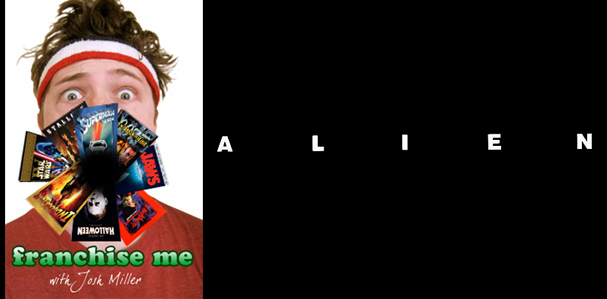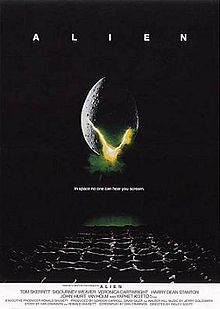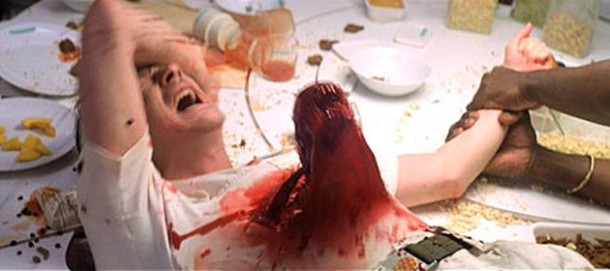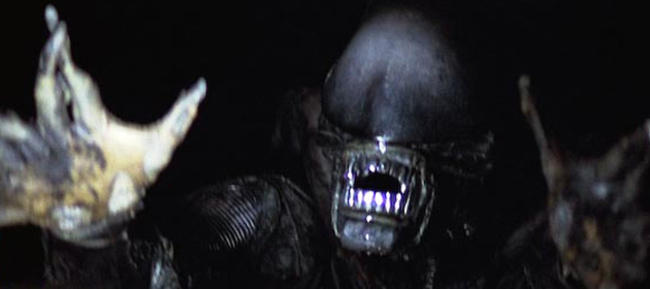
Hollywood loves a good franchise. The movie-going public does too. Horror, action, comedy, sci-fi, western, no genre is safe. And any film, no matter how seemingly stand-alone, conclusive, or inappropriate to sequel, could generate an expansive franchise. They are legion. We are surrounded. But a champion has risen from the rabble to defend us. Me. I have donned my sweats and taken up cinema’s gauntlet. Don’t try this at home. I am a professional.
Let’s be buddies on the Facebookz!
The Franchise: Alien — concerning the expansive universe of a deadly species of creature known as a xenomorph. The creatures have thus far appeared four feature films, as well as two spin-off films, literature, comic books, and video games. For the purposes of this column we will be focusing on the primary Alien franchise – detailing the saga of Ellen Ripley’s involvement with the xenomorphs and the equally nefarious Weylan-Yutani corporation – and 2012’s Prometheus.
The Installment: Alien (1979)

The Story:
The commercial towing spaceship Nostromo is on a return trip to Earth when its crew is awakened to discover their course has been altered by their employers with a new assignment — to investigate a distress signal from a nearby planet. On the planet they discover an empty spaceship. Well, it’s not so empty. While investigating a series of organic pods on the ship, crewman Kane (John Hurt), winds up with a small alien stuck to his face. Kane is brought back to the Nostromo, and eventually the little alien falls from his face, dead. Kane seems fine, until a new kind of little alien bursts from his chest. That alien doesn’t stay little for long, and soon it is killing off the crew members one-by-one.

What Works:
Everything.
Alien is a movie so uniformly innovative, influential, powerful and perfect that it is hard to decide where to even begin singing its praises. Or when to stop singing. It is also a movie that has been written about excessively since 1979. So in the interests of both brevity and superfluity, I’m going to limit myself to the three factors where the film is most truly successful…
1) The ideas. I’ve said it before, and I’ll say it again — I don’t think the true appeal of horror movies is gore, kills or even scares or tension. I think it is the ideas that the genre presents that make the stories so exciting, whether audiences are truly aware of it or not. At least such is the case for me. The ideas at play in Alien are so potent and indelible that it is almost hard to believe there ever wasn’t an Alien. And so I will sing my first song for the late-great Dan O’Bannon and his conceptual partner Ronald Shusett (who helped develop O’Bannon’s ideas for the script).
Controversy still rages over Alien‘s screenplay. I’ve never tracked down O’Bannon’s original script to compare with the shooting script — which was rewritten by David Giler and Walter Hill (who also produced the film). Giler and Hill claim they completely rewrote everything, changing nearly every single line of dialogue. O’Bannon claimed that they did little more than change the characters’ names in a cheap attempt to get writing credit. Shusett has always freely admitted that Giler and Hill created the twist that the ship’s science officer, Ash, was an android (which is a boffo twist). Giler and Hill have also claimed it was their suggestion to make Ripley female. Ultimately, O’Bannon won the WGA arbitration and retained sole screenplay credit. Personally, as a writer, I honestly feel for both sides. But even if all of Giler and Hill’s claims are 100% correct, no one has ever disputed that O’Bannon and Shusett are responsible for the film’s single most creative and successful factor: the Alien.
The xenomorph – as fans have taken to calling the creature – is possibly the horror genre’s most conceptually horrifying monster since Bram Stoker creeped his readers to their cores with Dracula in 1897. Like Dracula, the Alien’s metaphorical qualities are equal to its visceral ones. What makes it such a triumph is that by giving it a developmental and transformative life-cycle we’re actually getting three different monsters. 1) The facehugger plays into several innate fears and phobias. Its eight slender ‘fingers’ conjure subconscious thoughts of spiders and other creepy-crawlers. Its namesake modus operandi taps into fears of asphyxiation, smothering, and choking. And its acid blood evokes the venom of snakes, spiders or scorpions. 2) The chest-burster is a parasite, like a tapeworm, with subconscious ties to cancerous disease — the idea that you can seem fine, but have something killing you from the inside. It is a violation. And of course, just the idea of a creature bursting through your rib cage is absolutely terrifying. 3) The full-grown Alien is an explosion of symbolism and primal awfulness. It is perpetually drooling. It has no eyes. It is skeletal. Its head is a giant phallus. It has two mouths. One of those mouths can protrude outward. The xenomorph is truly a thing of nightmares.
The other key idea that only O’Bannon can lay claim to is hiring Swiss surrealist artist H. R. Giger to design the creature. What would this movie have even become without Giger? I’m hard pressed to think of a movie monster that represents a better marriage of concept and design than the Alien. Giger’s designs infected the entire atmosphere of the film, yet managed to stay somewhat contained too. Giger’s visions are biomechanical and sexually fetishistic, but the film itself is not. The Nostromo is utilitarian, plausible. Aside from the overabundance of blinky lights in the Mother communication room, the ship feels mundanely human. This helps make the Alien (and the Giger-designed ship on which the Alien is found) feel all the more alien. There is something dangerous about the way it makes you react, it seems sub-primal, further down past even animals. This is aided by director Ridley Scott’s decision to only show the creature in sparing flashes, which – especially the first time you’re seeing the film – make the Alien’s full layout nearly impossible to decipher. Like a nightmare, you’re left will only the vague puzzle pieces of its most terrifying aspects until the film’s final moments. Even then you really need to see the film a second time to get a better idea of just what the fuck you’re looking at.
2) The tone. Dan O’Bannon never imagined Alien landing an A-list budget. He conceived it as a low-budget Roger Corman creature feature; a scary revamp of his satirical John Carpenter collaboration, Dark Star. Then Star Wars happened and all of a sudden the studios wanted outer space tent-pole films. At the time Ridley Scott was a successful advertising director who had only made one feature film, the excellent Napoleonic-era drama The Duelists. He seems like a very wrong choice for something like Alien, but it turned out that he couldn’t have been better. Looking at O’Bannon’s other major works, Return of the Living Dead and Total Recall, I think it is safe to assume his original vision for the film’s tone was probably a bit broader and bent with dark humor. Alien is an inherently B-grade story — space-workers discover an alien ship, only to accidentally bring a different alien back aboard their ship, which then kills them all, the end. Ridley Scott’s decision to treat the film as a serious A-picture is what makes Alien such a beautiful oddity. It is It! The Terror from Beyond Space done with the air of 2001: A Space Odyssey.
The movie’s pacing is incredibly slow, but in a completely non-dated kind of way. While such pacing is typical with 70’s cinema, Scott’s contemplative execution melds with the script’s horror concepts to create a timeless atmosphere. What we get feels decidedly less Corman-exploitation and far closer to Lovecraftian-romanticism. In particular this approach fantastically enhances the first half of the film. Alien structurally breaks down into two horror archetypes. The first half of the film is a classic ‘old dark house’ movie. The alien spacecraft the crew is sent to investigate might as well have been a foreboding mansion that our characters discovered after their car broke down. The second half of the film is a classic slasher movie. The Nostromo might as well have been a sorority house, and the Alien a mask-wearing maniac plucking coeds off one-by-one. Scott doesn’t miss a beat during the slasher portion, but I think his execution of the ‘old dark house’ phase of the film feels the most inspired (the Alien itself is what sells the second half of the film). The ship they find raises so many goddamn questions – What is up with the giant dude they find dead in the chair? Did his crew put the Alien eggs there? Our crew doesn’t seem super surprised to discover a giant alien, so have humans encountered aliens before? – but the spectacle and tone of the art direction and visuals only seem enhanced by our cluelessness. Like the best Lovecraft stories, Alien works magic with its implications and what is left maddeningly unsaid. Actual answers are rarely as good as the tantalizing desire for said answers.
And Scott’s adherence to realism cannot be overpraised. Nothing about Alien‘s story begs to be treated realistically, but doing so strengthens the bizarre elements. The Nostromo feels real. The crew feels real. This helps the Alien feel real, despite being a preposterous construction — you actually overlook the B-movie reality of the xenomorph. I mean, how have the facehugger eggs survived for so long on this long abandoned, semi-ancient ship without nourishment (they even note that the dead humanoid they find looks “fossilized”)? How can something with acidic blood strong enough to eat through solid metal have skin weak enough to be easily pierced by a common surgical tool? How is it that the Alien grows roughly ten times in size after bursting from John Hurt’s chest even though it doesn’t consume anything in between? Who gives a shit. Few viewers probably even thought about any of that when they first saw the film because Scott lulls you into a sense of lived-in plausibility. You just accept and react to what you see. So watching the crew make rationalized and cautious responses to the film’s various conflicts comes off as charged suspense instead of masturbatory indulgence.
Jerry Goldsmith’s ominous score certainly helps too. Even without the film’s visuals the music creates an atmosphere of eery wonder and intensity.
3) The cast. This is really just an extension of the realistic tone Scott created, but it is important enough to deserve its own song. The cast is so good, and so smart in its assemblage. People always praise the choice of making Ripley female, but youngsters watching the film for the first time in 2012 won’t even think twice about it. Narratively, Ripley being a woman has no bearing on the story. It was interesting in 1979 only because it was different in 1979. I’m not trying to diminish the importance of this radical move, or the impact that Ripley had on cinema history, but the simple fact remains that making Ripley a woman doesn’t matter as far as the story is concerned. Women had been leading horror movies years prior to Alien. Ripley was only usual because she’d initially been written as a man, so she was uncharacteristically assertive for a female horror lead. My point is, there is absolutely no reason Alien wouldn’t have been as good with a male lead, but it may not have been as good without Sigourney Weaver. Falling all over the production’s decision to make Ripley a chick kinda steamrolls how fucking great Weaver’s performance is. Allow me a personal anecdote for a second: when I was younger I didn’t find Weaver attractive. I thought she was mannish. Now that I’m in my 30’s, my opinion has changed drastically. Why do I bring this up? Because I always loved Weaver anyway, in the most pure of ways — cause I thought she was a great actor. Ripley is such a good character because of how Weaver plays her. She just feels so real. She is great in every scene, but there are two scenes in particular where she really burns shit up. One is her confrontation with Ash after he lets the facehugger on board the ship. She bristles with hostility. The second is after Captain Dallas (Tom Skerritt) dies and she assumes control of the wary crew, which is possibly the best scene in the entire film as far as character-interplay is concerned.
The entire cast is amazing. Hurt, Skerritt, Veronica Cartwright, Harry Dean Stanton. Ian Holm’s performance only pops to its fullest on your second viewing, when you can re-evaluate his acting choices knowing that he’s A) a robot, and B) viewing the rest of the crew as expendable the whole time. But the major stand-out after Weaver is Yaphet Kotto as Parker. Part of Alien‘s appeal is that, unlike Star Wars, our characters feel like they’re from our own time. They may utter dialogue full of sci-fi techno-jargon here and there, but they don’t dress in silly ‘futuristic’ clothes, and their concerns and demeanor are entirely 20th-century. In this regard, Kotto is the secret weapon in the cast. Parker is the one who most grounds the film, and Kotto sells it 100%. When Parker is given an order, and he replies, “…soon as I finish my coffee. It’s the only good thing on this ship.” With that simple reply, you really get these people and this world. Griping about the quality of company catering? Still obsessing over coffee? Nothing has changed. And Parker is antsy to return to Earth. Why? “I want to go home and party.” Or his repeated shouts through the glass of the science room, wondering very loudly why they don’t freeze Kane and the facehugger, seem like the rational – if unsympathetic – response of a normal dude. Kotto nails the blue collar credibility. He just wants his bonus. So we know these aren’t astronauts or intrepid space explorers. These are truck-drivers or coal miners or oil rig workers. They just happen to work in outer space.

What Doesn’t Work:
Nothing.
That said, though the film plays with a lot of unanswered questions, growing up there were a couple odd holes in the film that always nagged at my mind — until the DVD era. Generally in this column I try to act as though each installment were brand new, that I didn’t have the luxury of retrospect and certainly not the luxury of watching a DVD with deleted scenes or alternate takes. But considering that some deleted scenes truly highlight existing queries I had with Alien, it doesn’t seem entirely breaking with tradition to discuss them here. Plus, it is sorta dull to have zero comments in this section.
Parker and Lambert (Veronica Cartwright) tell the rest of the crew that they witnessed the Alien pull Brett (Harry Dean Stanton) into the ventilation system. This is odd, because the way Brett’s final scene was presented, it seemed as though the Alien was going to kill him. So, did the Alien kill him? Or just abduct him? Also, Parker and Lambert weren’t even in that scene. Why didn’t we see them witness this? Then no one, not even Ripley at the end, ever finds any corpses or pieces of corpses. There is even a stray line of dialogue acknowledging that the Alien seems to be swiping people, not merely killing them. In Alien‘s most famous deleted scene, Ripley discovers the Alien’s nest where the creature has cocooned its victims. This explains everything. It was abducting them. The reasoning of why Scott left out this major revelation – as intriguing as it may be creatively – is immaterial here. What is material is why he left any of the remnants of that revelation behind. Why have Parker and Lambert note that Brett was taken away by the Alien? Why have anyone wonder aloud what the Alien was doing with them? Ripley discovering all the bodies strewn neatly about in a single location is completely in keeping with the slasher structure of the second half of the film, but considering that the xenomorph seems more like an animal than Jason Voorhees, I would have safely assumed the Alien was eating all of its victims. Keeping an ambiguity doesn’t actually add to the film, especially when the film was originally written/shot/edited with an explanation of the Alien’s agenda. It feels like something is missing. Cause it is.

Kills: 6
Best Kill: Kind of hard to top Kane’s chest-bursting death.
Best Scare: Dallas’s very sudden death in the air duct, after an equally tense scene in which the Alien can only be seen approaching him as a blip on the radar.
Best Line: After being decapitated, revealed as an android, and temporarily re-activated to answer some questions.
Ash: I can’t lie to you about your chances, but — you have my sympathies.
How ‘The Corporation’ Fucked Up: They should have offered huge bonuses to the crew for capturing a specimen. Maybe things would’ve gone down differently if Dallas’ team had brought proper equipment.
Should There Be a Sequel: I demand it!

Up Next: Aliens
previous franchises battled
Critters
Death Wish
Hellraiser
Home Alone
Jurassic Park
Lethal Weapon
Leprechaun
Meatballs
The Muppets
Phantasm
Planet of the Apes
Police Academy
Psycho
Rambo
Tremors